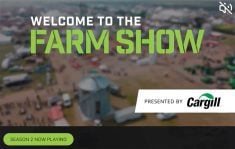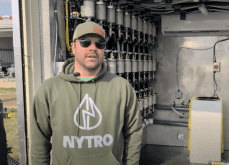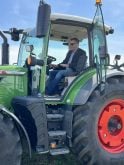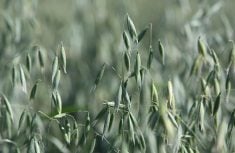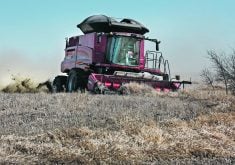Five producers in the Melfort, Sask., area have field-scale GreenSeeker projects on their own farms.
Their goals and what they seek to accomplish with the device is as varied as the farms themselves. While some see an immediate payback, others see the GreenSeeker as just one piece of a giant puzzle that goes by the name “nitrogen.”
Mineralization
One of the producers looking at the long-term impact of the GreenSeeker is Vince Walker, who says that a better understanding of the mineralization process is vital to him.
Read Also

VIDEO: Ag in Motion documentary launches second season
The second season of the the Western Producer’s documentary series about Ag in Motion launched Oct. 8.
“Initially, I think the idea behind GreenSeeker was to make immediate decisions about top dressing nitrogen in the growing season,” said Walker.
“But I’m not really interested in top dressing. I’m not saying I wouldn’t do it, but I think it’s impractical to think you can be there with the right amount of nitrogen in every field on your farm at the exact right time.
“I had been a longtime user of soil tests, but I became so frustrated with the cropping results. I’ve concluded there are too many variables we do not yet understand. I plan to use the GreenSeeker to get a better understanding of the mineralization ability of the soil.”
Over the past six years, Walker has run test strips in his fields that have no nitrogen applied. He said he has been amazed at the good yields he gets on some fields that have zero nitrogen. Last year he began running half-rate strips, with the same positive results.
“High yields without nitrogen is not a long-term deal. It’s a result of excess nitrogen in previous years. But it points to the need for a better understanding of mineralization under the different circumstances you get from year to year.
“We’re hoping to establish some yield response algorithms for spring wheat in our area. Once we’ve done that, I’d like to get to the point where I can set down a standard criteria to predict what nitrogen my crops require under different circumstances. This is a very long-term project.”
Little machine, big impact
Hans Van Burck said the machine is designed to see if the plants already have enough nitrogen or if they need more to perform better.
The Star City, Sask., farmer thinks technology such as the GreenSeeker will play a major role in the future of farming on the Prairies.
“We are not getting more money for our product. It seems we are getting less and less. We have to become more efficient in our expenditures on every acre we farm. If we can cut our fertilizer down by 40 or 50 percent, it makes the GreenSeeker a highly valuable tool.”
Van Burck said that before being introduced to the GreenSeeker, he had put all his fertilizer down at seeding. That was always a risk because he never knew what kind of weather was coming that summer.
“Too little nitrogen means we don’t get all the yield those plants can potentially give us. But you want to be careful about too much N because you waste money and run into maturity problems, particularly in a year like 2004 where delayed maturity was a bad thing because of the frost.”
The only measure farmers had before was a soil test that gave a range of answers.
“And the answers never matched up. If you have a quarter and you have maybe 10 soil samples, it doesn’t really mean a heck of a lot.
“A soil test never tells you what the plant needs in the growing season. Now you can go in with a GreenSeeker in the four to five leaf stage in the middle of June or the end of June and do the analysis on the plant right in front of you. That’s way more accurate and you have an immediate answer.”
Van Burck said the GreenSeeker is not yet developed to the point where an individual farmer can buy it and put it to good use right away. He thinks the development and acceptance will be similar to that of the personal computer.
“They started out very expensive and not very easy to use. Now the computer is $1,000 and everybody uses them. Once people start to see the benefits of GreenSeekers, they will start using them and they will become quite affordable.”
Customized fertilizer
Brett Casavant has been using a GreenSeeker on his Tisdale, Sask., farm for two growing seasons. In that time, he has developed enough confidence in the instrument that he is buying the machine from Omega Research.
Cost recovery should not be difficult, Casavant said.
“If you make serious adjustments to your fertility program based on this information, you can easily recover the cost in one year.
“On my land, we found huge variances in fertility response with the GreenSeeker. I’m using the information to pinpoint areas where I need more fertilizer or less fertilizer for my variable rate. So my cost recovery is going to come in having a fertility package that’s custom tailored for every field.”
Casavant is using the GreenSeeker more to find out how his soil is performing in the long term, rather than just how a specific wheat crop is performing on a given day. He sees it as a soil instrument rather than a plant instrument.
For the past two years, he has tried using the GreenSeeker to manage in-crop nitrogen top dressing, but so far it has not been worthwhile. In one field, he tried putting on 15 pounds per acre of foliar nitrogen, even though the GreenSeeker data said it wasn’t necessary.
The result was a later maturing field and the accompanying frost damage in August. For 2005, he wants to try the same thing again, only with dribble banding instead of foliar.
“That was my original intent,” said the former computer software engineer. “I was only going to use the Green Seeker for in-crop decisions in the current growing season. But now I can see that it tells me so much about the soil, so it’s become more of a planning tool than an instant response tool. The data I gathered in 2004 is being used to plan my 2005 fertility program.”
Tracking toxicity
Stacey Moskal thinks the GreenSeeker can be a good trouble-shooting tool. The Brooksby, Sask., farmer said it’s hard to find fault with a machine that can tell you what happened in a field four years previous.
“We had a field in alfalfa,” recalled Moskal. “Four years ago, we ripped it up so we could put in crop. So the first summer we had the field back in crop, it all got hailed out.”
He didn’t see a good crop on that field until 2004. On July 4 last summer, Moskal had some of his fields scouted with the Omega Research GreenSeeker. On that date, the device picked out the field that had previously been in alfalfa and said nitrogen levels were dangerously high.
“The mineralization of the nitrogen from that alfalfa had carried forward three crop years,” Moskal said. “That’s the kind of information farmers need if they want to do a better job managing nitrogen.
“We’re never going to see a return to cheap nitrogen prices. It’s just not going to happen. The price will only go up from here, and we’re going to have to learn to live with it. That’s why we need tools like this.”



